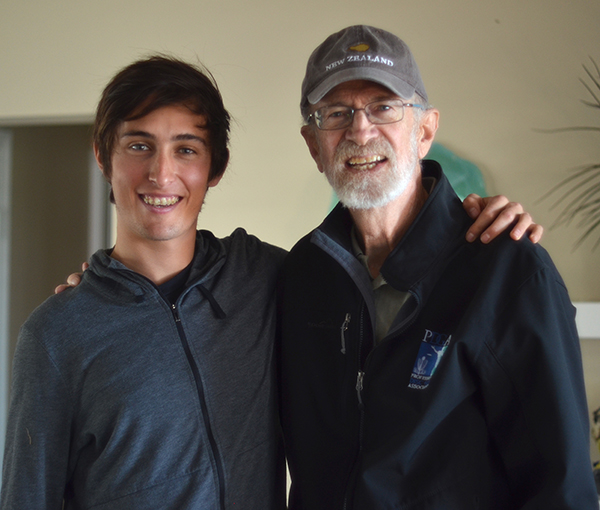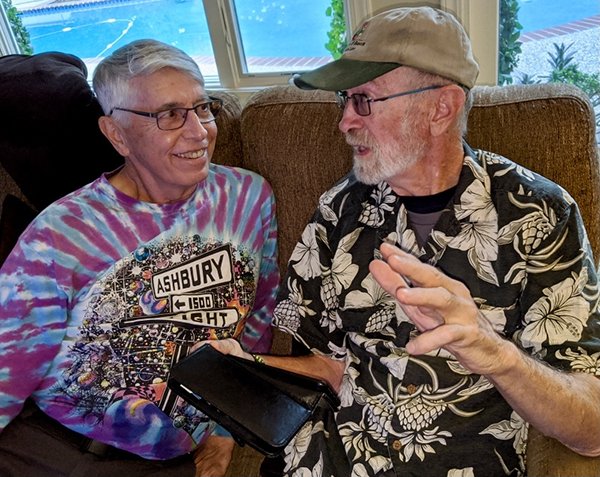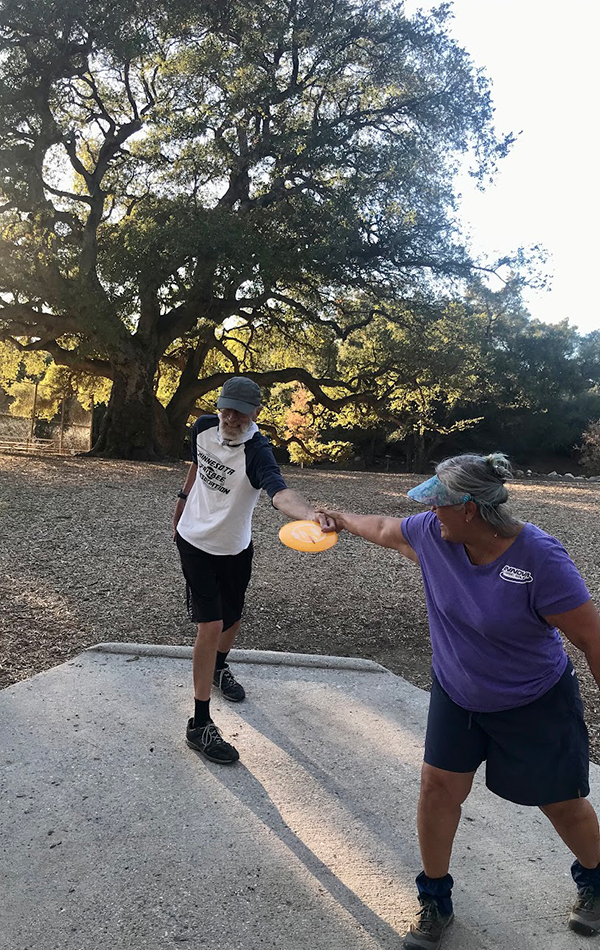Why I Still, Still Play: The Path to Finding Fun
Why I Still, Still Play: The Path to Finding Fun

This article originally appeared in the Winter 2022 issue of DiscGolfer Magazine.
A while back, I wrote a piece entitled “Why I Still Play.” You can still read it at PDGA.com. Back then, I was in my early 60s and I shared my thoughts about playing at such an advanced age. Now, as I approach 75, I’m struck by how differently I view the game, and many other things.
I never really played much recreational golf. It’s wonderful to have a career in disc sports, but it doesn’t mean that you will get to play often. I just didn’t have many chances to get in a round of golf. My competitive interest through those thirty years or so was overall events. When I did get time to play, it was spread out over those seven events. The social appeal of ddc or a freestyle jam also kept me off the golf course. Almost all of my golfing was in big tournament events. Who needs practice? I knew how to play. After all, I did once win a Datsun. I wasn’t terrible. I was short off the tee, but a pretty sharp approach game and decent putting kept me in the mix. My expectations weren’t set too high because I really hadn’t put in enough work to deserve consistently excellent results.
You could tell by looking in my bag that I was stuck in the 70s; old, old school. A Gumbputt, Wham-O 141 G approach, a light Stingray for drive and fairway and a heavier one for rollers. However, I did know exactly what those discs did. I managed a respectable rating, nosing occasionally up into the 900s. My main pleasure was the interaction with my cardmates, which is the same reason that I like poker, pickleball and other social games. It’s much more about the competitive ebb and flow than the eventual result, That said, it’s considerably more fun to play well than badly. And, especially off of the tee, I sucked. To be a bit more generous, I did have a decent throw, but it just didn’t work well for modern discs. When we were first playing back in the 50’s and 60’s, PapaJack and I threw backhands with lots of hyzer, though we didn’t yet know Stancil’s term for the angle of release. We loved to float the platter, slowly through the air, nose up, in a mild “air bounce” all the way. We didn’t know that term either until 20 years later when the globetrotting John Kirkland shared that trick with me. So, it was the hundreds of hours in that backyard that imprinted my throw.
40 years playing the Wintertime Open
The one tournament that I have consistently played is the Wintertime Open. It was hosted for 40 years by the Horn family at the world’s first permanent course in Oak Grove (now Hahamongna) Park. Fortunately for me, the park is just a short drive from our home in Pasadena. But, of course, I almost never practiced the course; not me.

How can he throw soooo much farther? / Photo: Dennis Warsen
Then, in 2019, Eagle, his dad and the Korns family were staying with us for the event. This was to be the reincarnation of my disc flinging life, just 66 years from when Dad and I started tossing our Pipco Flyin’ Saucer. During that Wintertime Open, Doug and I spent a lot of time studying Eagle’s throwing mechanics. The nagging question was how, with body dimensions pretty similar to mine, could the boy possibly throw twice as far as I could? I decided that it was something that I simply had to understand. Doug took multiple videos of my backhand throw and we spent quite some time comparing my videos with those of Eagle and other top throwers. After careful study, Doug and I came to the conclusion that I was doing pretty much everything wrong. I needed to start from scratch. This was a daunting task, given the massive investments I had accumulated in my muscle memory bank.
However, like many worthy projects, it got delayed. Life and pickleball intruded, putting that challenge on simmer. Months passed and then … there was this virus that changed pretty much everything. Janet and I essentially became hermits, which, it turns out, is not an entirely unpleasant lifestyle. But, as the promised two weeks stretched into months, and the pandemic news grew ever worse, I saw my weekly screen and couch time rising ominously. Was it to be, “Elderly Local Man, Former Frisbee Champ, Avoids Covid, But Succumbs To Netflixitis”? That was a trend that I had to reverse. In his 90’s, PapaJack was setting world distance records! It was time for me to get moving.

Doug identifying a few problems
Afternoon field work
Late every afternoon, into dusk, I began going to a big field near our house with a stack of about 30 discs. A real problem was that I didn’t know how they flew. Online, I researched what each of them were supposed to do. That was a start.
Unfortunately, something about my throw turned these speedy little jet fighters into lumbering cargo planes. The many offerings of on-line advice was amazingly helpful. It actually became overwhelming as I accumulated various tips to try. At one point, I recall having nine distinct elements that I wanted to keep top of mind on each throw. Do remember that Doug’s videos showed that I was doing almost everything wrong.
All of this confirmed for me that the mechanics of throwing a disc are tremendously complex. I know that hitting a tennis serve, chipping a golf ball or throwing the discus all have their complexities, but I’d still argue that disc throwing has more considerations. But let’s not argue… Let’s just say that there are many things that contribute to an optimal disc release. And yet, with all that complexity, when you see Simon or Paige unleash an awesome drive they make it look so maddeningly simple. But was I strong enough to throw effectively? Watch one of Ezra’s many impressive videos and you could easily come away thinking that you should to be able to bench press a truck to throw far. I’m sure that his exceptional strength is helpful, but many other players, including my senior cohorts demonstrate that it’s not essential.
I started from the ground up. A few years back, Avery had suggested that my plant foot was restricting my turn. I had my foot pointed toward the target. When I released, it never moved. Watch Paul’s plant foot on a big drive. It explodes with rotation when he releases, turning 90 degrees in an instant. Avery had been right. I was trying to shoot the gun without even having my finger on the trigger.
I concentrated on replicating the prep, turn and pull though of the throwers I was attempting to emulate. My mantra was “They are right and I’ve been wrong. If you want to throw like Ricky … throw like Ricky!” It’s not a magic trick! They show you exactly what they’re doing.
Every evening for months I launched set after set of throws, experimenting with every aspect of my delivery. In the beginning, I was expecting that I would quickly find the key element that had been holding me back; making a change in some aspect of my throw that would immediately unleash an extra 30 meters of flight. But that’s not how it went. An idea seemed to work well for a few days, and then seemingly lost its effectiveness.
But here’s the fascinating thing — even though I was not having the dramatic success I had imagined, I was becoming addicted to the quest! To my amazement, I was (and remain) incredibly optimistic about each and every throw, thinking that this next one will put all the elements together. The result was that I just couldn’t seem to stop throwing. It was always just one more set, usually only ending when I had to find the last of my throws by the light of my phone. Crazy! Here’s a guy who’s been throwing plastic around for almost 70 years and he’s late for dinner because he couldn’t stop throwing? How can that be?
Games make it fun
I think that I have figured out why it’s been such surprising fun. For all those years I enjoyed playing, but it was the games that made it fun. Ultimate, freestyle, ddc, discathon, scf or any of our games are fun in themselves. I enjoyed the playing even though my throwing efficiency was never great. And now, I was finally experiencing a taste of what many others had always enjoyed. Over the years, many friends had taken pity on me and offered very useful advice. Harve/Tyler/Jon/JK/Cliffy/Beth&Tita/both my Jacks and many other folks really tried. Everything they said was helpful, but I just couldn’t break my old, comfortably well-worn habits. It was much like when I used to teach tennis and a student would show up with a mechanically terrible, but fairly effective, serve. Picture someone swatting a fly overhead really, really hard. It works at a certain level (fly definitely dead), but no chance of the serve ever getting better; never gonna hit a big American twist. So, I had to ask, “Are you satisfied with what you’ve been doing or are you ready start over and be pretty bad for quite a while until you eventually get the benefits?” Some signed on for my service boot camp and others continued happily swatting flies. It just depends what you need. I had finally decided that I needed more.
My fly swatting was basically all arm, trying futilely to make the disc move faster by pulling as hard as I could. I was simply trying to muscle it out, which is not a great plan for a guy who’s not too muscular. However, I do have a very long set of levers and this gave me hope that I could at least attempt to emulate what Eagle does so effortlessly.

Tips from Tita
Roadrunners, Wraiths and Terns
But, back to the discs. They were all faster than what I had been using for years. They were mostly Roadrunners, Wraiths and Terns, as light as I could find (thanks B&T), on the theory that I could accelerate 140 grams more easily and also get them to turn over for me. To my disappointment, regardless of the expected characteristics of the discs, they flew with no real glide and hyzered out early. I do know enough about disc aerodynamics to realize that when they fly even a bit “nose up,” all bets are off on performance. That was a huge problem that had to be solved.
Over many weeks, I worked on all the components that could be involved; grip, pull back, rotation, pull through, release and follow through. I obsessed on every one of those elements for months. When I would finally get home from throwing, Janet would be kind enough to ask how it went. I’m certain that my answers nearly drove her nuts. Almost every night I would have one or two new “secrets” that I had discovered in that session. Often just one throw had shown a glimpse of a new possibility. Fortunately, Scott Zimmerman was always willing to take my calls and help me sort through my discoveries d’jour. Scott spared Janet from the worst of it although I still spent a lot of time walking through my delivery in every room of the house. “Honey, did you hear that snap? It does look faster, right?” She is patient.
Years ago, I watched Dave Feldberg get warmed up for a distance competition by snapping a towel. It would have been a deadly weapon in a junior high locker room battle. All of this was slowly starting to fit together for me. That’s why they call Michael “Captain Snap”! Dave Dunipace’s video on the Tip of the Whip was making sense to me. Now I was concentrating on the speed at the very end of my release and having the turn of my body sling my arm through, rather than working so hard at the start of the pull. And, as I watched the full follow through that so many of the best women throwers were using, I knew that was really important. They practically complete a 360 from beginning to end of the throw. Watch a Mandujano sister (either one) … simply amazing.
Gradually, I was beginning to see some of my discs perform as advertised, with that magical extended glide and turnover. Each of those were exhilarating as they demonstrated that I actually could get the nose down and allow the disc to perform. Those flights, which in the early going came only rarely, were what drove my addiction. They were the reason I kept throwing into the dark, because I always expected the next throw to be that one.
Even though I’m now more consistently able to experience that flight, it has lost none of its thrill. I’m still feeling that eager anticipation before each throw. Maybe lots of other players feel that way. I imagine that when Big Jerm or Catrina step onto the tee pad they must feel like opera stars ready to unleash a thrilling aria. For now, I’m delighted to finally be able to carry a tune.
OK, time to golf
After months of throwing, I realized that it was time to actually try some golf shots. It’s one thing to blast away in the open and quite another to tailor a shot to a challenging fairway. I hadn’t played at all for over a year. By that time, the pandemographics had created the global surge in disc golf interest, and our local courses were packed. However, when I discovered that they were nearly deserted in the early morning. At first I played solo, but soon talked my buddy Dan Mangone into joining me. He and I had not golfed together for over 30 years. After a few outings, We joined some other (vaccinated) friends as well. Our play has been great, multi-format fun, with lots of laughs. All these folks have helped me continue my quest since they have apparently known how to throw correctly for years. Of course, almost every time we let a youngster (that is, anyone) play through, they step up and fast twitch a forehand surprisingly far, often toward the basket. Kids …
The point is I’m now reaching holes that I never could in the past. My goals are very specific. I want to optimize my ability, and most importantly, be able to create the flights that I envision. It turns out that both of those things are tremendously satisfying and completely addicting fun. Who knew? I guess almost everyone who reads this magazine does. But, it’s the process of improvement that is my joy. I have no plans to be finished. As has been said, “If the path is beautiful, no need to ask where it ends.”
Still … happy to be throwing my life away,
— Stork (003)
Stork has been playing and designing fun and challenging things to do with flying discs for over 60 years.
- posted 1 week ago
- posted 1 week ago
- posted 1 week ago
- posted 2 weeks ago
- posted 2 weeks ago
- ‹ previous
- 2 of 699
- next ›
- posted 3 years ago
- posted 3 years ago
- posted 4 years ago
- posted 4 years ago
- posted 4 years ago
- ‹ previous
- 2 of 4
- next ›
